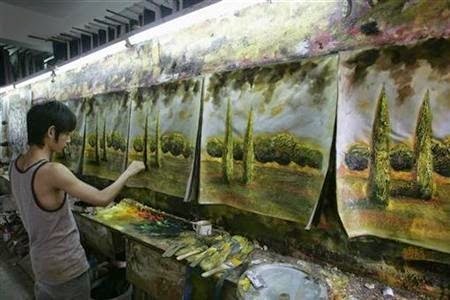Two days into my time at Da Wang my colleagues left for a 5-day field trip to Chengdu in Sichuan Province to visit the world's largest Buddha, sample the cuisine and explore the gallery scene. I was invited but with such short notice and only a month to work at the residency, I decided to stay behind. It seemed like the perfect situation to engross myself into working without distractions, and it was just that.
I wasn't physically alone. Ayi the cook, Miswang the housekeeper and Shiny the receptionist were there to assist me with anything I needed. But with the exception of Shiny, no one I interacted with spoke English. I ate several meals alone with sweet Ayi sitting across from me and us both just smiling at each other. I worked all day with many people around me but no one I could talk with. Add to this that most access on the internet is blocked by China's wall, which didn't matter since by this time we lost our wifi connection anyway. This type of isolation was a first for me. A strange social space for someone whose work is about engagement.
In the studio I was experimenting with the rubbings of the window onto the propaganda magazines and decided to add embroidery. I needed to find some needles and thread, preferably silk. So I enlisted Shiny and her dictionary to write out the symbols for all the items on my shopping list and off I went into Shenzhen city.
 |
| With Shiny's help I compiled a collection of chinese translations for my shopping list and used them to communicate with in the city. |
After a 20 minute walk to the village, and a 30 minute bus ride to Shaibu, I arrived at the fabric district armed with my book of Shiny's characters to be used like flashcards with any vendor who I could find. I was looking for thread and needles, but each person directed me to a bolt of a velvety fabric. After about 4 tries, it was clear that I didn't have the accurate translation. At this point I'd been searching for a few hours, and determined to return home with my tools, I was not ready to quit.
 |
| The fabric district is enormous with endless city blocks of tall buildings, each packed full with hundred of vendors selling nothing but fabric. Seemed like a logical place to shop for thread. |
So the next time I was shown to the bolt, I pulled out a thread from the fabric and mimed a gesture for sewing. The young man, about 18, patiently spoke the word 'xiàn' and laughed. I once again shoved the book in front, with a pen, and asked if he could write it down (another mime).
With some encouraging and lots of laughing among his friends, he made me another flashcard, this time a single character for thread 线.... At least that's what I thought it was but who really knew?
 |
| My elusive chinese character for thread, xiàn. |
It was in fact correct. I tried it out in the next building and was promptly led up 3 flights to a floor that was nothing but thread, zippers, buttons and other accessories. I felt victorious and happily went to work at trying to communicate with the lovely thread vendor who helped me choose colors.
 |
| Thank goodness for calculators as the universal communicator of numbers. We negotiated pricing back and forth by punching in the appropriate amounts. Where there's a will there's a way! |
I left Da Wang for the city after lunch, and the sun was setting by the time I found my thread and needles. It wasn't silk like I wanted, but it's what I could get my hands on, it's what I had, and I would make it work.
 |
| Exhausted, I flagged a taxi and braced myself for yet another mime routine, this time with the driver to get me back to Da Wang. |
 |
| An embroidery study with my newly acquired threads! |
 |
| The primitive character for thread. A stamp I had carved to commemorate the day and my new connection with China. |
This post is part of a series documenting my experiences in China.
Please follow previous entries by using the blog archive in the sidebar to the right. Or click here for the beginning.















































